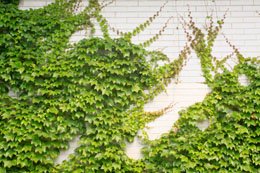For gardeners, the English ivy plant is an ideal houseplant, whereas for other people, it is a noxious vine that spreads quickly. If you are interested in planting English ivy, read this article to understand the basic tips of growing this hardy vine.

The English ivy plant, (scientific name
Hedera helix), belongs to the Araliaceae family, with 15 other species of climbing vines. Maintain English ivy as a ground cover plant and it will spread horizontally, reaching a height of about 8 inches only. It is also grown as climbing vines, wherein aerial roots help in attaching to support structures. Let's try to learn the basics of this plant in terms of identification, planting, care, and controlling (if necessary).
The poison ivy plant serves as an excellent vine to cover trenches and walls in the garden. Like the poison ivy, English ivy leaves too are poisonous to pets and humans. So, adequate care must be taken if you decide to grow this plant.
Identification
English ivy leaves are not retained throughout the year, even though most ivies are classified as evergreen woody plants. The leaf lobe may be shallow or deep. Also, the foliage size varies according to species; some may have small leaves, while others have larger leaves. At maturity, the plant measures a height of about 5 feet from the ground, with a stem diameter of about 5 inches.
Propagation
The plant is propagated by means of stolons, stem cuttings, and bare root cuttings. You can snip off the vine below the node, having a length of approximately 5 inches. Remove the leaves from the lower portion, and keep it for rooting in soil or water. Once you notice the development of roots, transplant it, either outdoors, or to containers, depending on your choice.
Growing
One fact is its popularity as perennial houseplants in zones 4 to 9, despite its poisonous leaves. Planting should be done in well-drained soil, and in an area that receives partial to full shade. Hence, you can successfully grow it in indoors as well. The ideal soil pH range is between 5.2 and 7.8. As long as you provide moderate irrigation, the plant grows luxuriantly.
Care
You will notice English ivy growing at its peak during spring and summer. It blooms in late spring, producing inconspicuous greenish flowers. Trim the plant in spring to give shape and minimize disease attacks. While maintaining them as indoor hanging plants, make sure you give special attention in terms of watering and checking disease infestations.
Controlling
As the plant is introduced, and not native to United States, there is no natural mechanism to control its spreading. Hence, keeping a check over growth and spreading is an essential step, especially if you are growing it outdoors. It grows aggressively, covering everything that comes in its way. Pick the leaves if grown indoors, and prune the branches if grown outdoors.
At times, nurseries put up English ivy plants for sale, which is the best opportunity to buy this evergreen vine at low prices. Otherwise, saplings are commonly sold in all plant centers. In landscaping, the English ivy plant is an important vine for covering bare soil in complete shade, where most other plants fail to grow properly.






 The English ivy plant, (scientific name Hedera helix), belongs to the Araliaceae family, with 15 other species of climbing vines. Maintain English ivy as a ground cover plant and it will spread horizontally, reaching a height of about 8 inches only. It is also grown as climbing vines, wherein aerial roots help in attaching to support structures. Let's try to learn the basics of this plant in terms of identification, planting, care, and controlling (if necessary).
The English ivy plant, (scientific name Hedera helix), belongs to the Araliaceae family, with 15 other species of climbing vines. Maintain English ivy as a ground cover plant and it will spread horizontally, reaching a height of about 8 inches only. It is also grown as climbing vines, wherein aerial roots help in attaching to support structures. Let's try to learn the basics of this plant in terms of identification, planting, care, and controlling (if necessary).